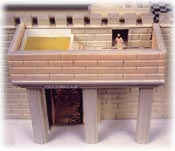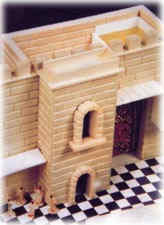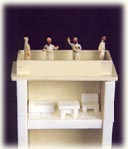Shaar Hamayim - Water Gate, and its adjacent chambers
During the festival of Sukkot, the Kohanim drew water from the Shiloach Brook, and brought it through this gateway. The water gate was open only during the festival.
 Mikvah - The Ritual Bath
Mikvah - The Ritual BathAbove the water gate was a mikvah. It was used only once a year, by the High Priest on Yom Kippur.
On that Holy Day, the High Priest immersed himself five times in a mikvah. The first immersion was done here. This mikvah above the water gate, may also have contributed to the Gate's name.
The water gate took its name as well from the narrow stream of water that flowed from beneath the foundations of the Heichal, across the courtyard, and out through the Water Gate.
 Lishkat Avtinus - The Avtinus Chamber
Lishkat Avtinus - The Avtinus Chamber
To the right of this gateway (inside the Azarah) was a chamber called the Lishkat Avtinus.
In this room, the incense that was offered on the golden Altar was compounded. The chamber was named after an illustrious family of spice makers. They knew of a certain ingredient, which, when added to the incense, made the smoke rise in a straight column. They refused to divulge the name of this ingredient lest others use it for idol worship.
 During
the Second Temple period, the High Priesthood was a political
appointment based on reasons other than merit. Often the priest was
unable to read Hebrew.
During
the Second Temple period, the High Priesthood was a political
appointment based on reasons other than merit. Often the priest was
unable to read Hebrew.It was in this Chamber of Avtinus that he was taught how to present the special Yom Kippur incense offering, which was burnt in the Holy of Holies.
In Addition to the Water Gate, the Southern side of the Temple also had several additional gateways: 1) Sha'ar HaBechorot - Gate of the Firstborn; 2) Sha'ar HaDelek - The Firewood Gate and 3) Sha'ar HaElyon - The Upper Gate.
Sha'ar HaBechorot - Gate of the firstborn
The firstborn offering was one of the more common sacrifices of lesser sanctity and was therefore brought into the Temple through a southern gate -- to indicate its relative unimportance.
Some say that when Abraham brought Isaac, his firstborn, to be sacrificed upon the mount he walked over this area.
The forests of Jerusalem were located west of the Upper City. The wood was cut down and brought in through the Kiphonus Gate, the only gate on the western side of the Temple wall to lead directly onto the Temple Mount.
The wood could not be brought in through the western gates surrounding the Azarah, because those gates were narrow and small.
The wood had to be carried around to the southern part
of the Azarah and brought in through one of those gateways, which was
called the Gate of the Firewood.
The firewood from the Wood Chamber was also brought into the Azarah through the Gate of the Firewood.
Sha'ar HaElyon - Upper Gate
The upper gate - not to be confused with the Nikanor
Gate that was also called the Upper Gate - was the highest point on the
Temple Mount.
No comments:
Post a Comment